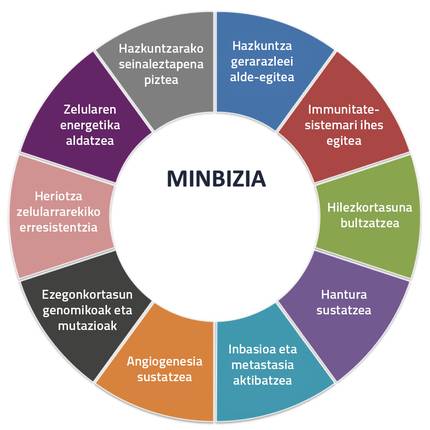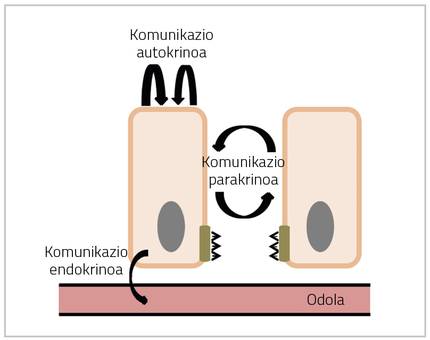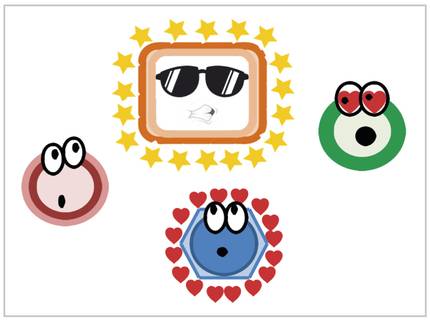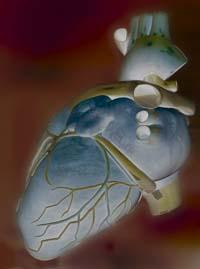CAF-Elhuyar 2019: Cells are online
2019/05/15 Maider Beitia San Vicente - Osasun Zientzietako IkertzaileaEHU | Itziar Urizar Arenaza - Osasun Zientzietako IkerlariakEHU Iturria: Elhuyar aldizkaria
Cells live in tissues forming organs, as humans live in cities. These groups of cells function as social communities, constantly interacting with each other. To do this, human beings have many ways of communicating and, at present, we can contact with the same ease both with people living at 10,000 km and on the next door. However, although humans admire the belief that we are creators of all these technological advances, cells began to use similar media long ago. Thus, analyzing our attitude of communication between humans we can understand the normal and pathological behaviors of the cells of our body.
Suppose, therefore, that our body has the social organization of a city. In a society the contribution of all citizens is necessary for the proper functioning of society. To do this, it is necessary that workers perform functions in each of the sectors, such as the cleaners who keep the streets clean, the researchers and doctors in charge of keeping people healthy, or the mayors in charge of coordinating all the guilds that make up the city, among others. In any case, it is essential to ensure coordination and communication between all these sectors to effectively advance the system as a whole. Otherwise, these areas of work would be affected and affect the entire city.
In our body we find a similar situation. Precisely for the proper functioning of the organism, the organs of our body perform specific functions. For example, in the kidneys live renal cells essential in cleaning work that intervene in the filtration of urine; in the spleen, the healing cells that form the army of the immune system, and in the brain, neuronal authorities with control power of all organs.
In this way, both in the city and in the body, effective and efficient communication between workers is essential. But we all know that it is often not so simple to communicate, and for this we need a small impulse: communication tools. Just by looking at our phones we can see that a large majority of the population uses at least one technological tool to communicate (the Apps).
We do not spend any day without sending or receiving a message via Whatsapp or Facebook networks. Photos, videos or audios are essential to bombard information at all times in our environment. But this service is not free and we expect a response from the recipient by making our information visible. In the case of the Facebook network, to detect the acceptance or rejection of others it is essential that the shared photos receive a “like” or not.
Cells are also in constant communication, but they do not send messages through social networks. Instead, they communicate by exchanging molecules such as peptides, proteins, and hormones. In this case they also receive responses such as “like” or “dislike” from nearby cells. In fact, this communication can have a positive or negative effect on receiving and emitting cells, as certain internal inhibiting or activating signals are to be activated, often through phosphorylation chains. In any case, signaling will generate a specific physiological response, causing changes in cells, growth rate or metabolism, among others.
Human beings currently have countless ways of communicating with the closest or distant. And of course, the cells do not stay behind. They also have different forms of communication to receive and send information from the internal and external environment. For example, cells found in the same organ use paracrine communication by exchanging molecules. In this way, from the window there are conversations with the neighbor who lives next door. Endocrine communication, on the other hand, occurs between cells that live in remote organs, that is, it would be like contacting a relative who lives on the other side of the planet (Figure 2).
But sometimes, like humans, cells get bored of limiting their relationship to speech. Cells also need carnal love. Therefore, just as humans use Tinder or Grinder networks, cells form specific relationships through integrin or adherine molecules to form tissues.
But, of course, these relationships are not forever, and over time they can break, then the cell only goes a while. In fact, cells can make deep reflections with themselves through indigenous communication. To do this, they extract selfies and send information about the interior and exterior environment.
Although these forms of communication are essential for the well-being of individuals in a community, we all know that a balanced and modal use of social networks is not always made. Who has not been conditioned by a situation he has found on social networks? Who has not made indiscriminate use of social media at some point in his life? Any beneficial instrument, without responsible use, can have negative consequences. And, of course, the tissue cells of our body are not safe from such a situation.
In normal conditions, the communication between cells is carried out on a regular basis, allowing for growth, migration, differentiation or balanced metabolism. However, a change in the behavior of a particular cell, often by mutations, may occur and control of the use of communication tools may be lost. This loss of control often starts with the desire to show a false reality. The photos of the holidays that humans upload to the Instagram network are so similar, since many times, to make them more spectacular, we model them disfiguring the truth: the brightest color of the sea or the sunniest color of our skin, among others. But why do we? As mentioned above, to get the recognition of our neighbors, that is, arouse the interest of followers or followers.
Like us, cells do not always show their crudest reality. Sometimes, cells can scam the immune system by emitting false signals, fleeing scammers' hunting immune cells, thus ensuring the survival of the fraudulent cell. But the worst news is that we are insatiable. Fame calls for more fame. A cell, in order to gain power, will continue to send transformed information to the environment, assuming the role of pioneer. Nearby cells will assimilate the contaminated message and begin to mimic the precursor cell for approval (Figure 3).
Without realizing it, the cellular community has protected the toxic influencer that only wants power and followers: the influencer is here. This leading cell will gain more and more strength in the community, change the functioning of society and eliminate the basic functions: cancer in the cell community.

However, the leading cell that begins to emerge in the community must acquire certain capabilities to ensure uncontrolled and unlimited growth. These capabilities are called hallmarks of cancer and are currently classified into ten groups (Figure 4). The best known are the capacities to favor the mechanisms of growth, avoid stopping growth or avoid death. In addition, cancer cells, based on their passion for continued growth, will need food and oxygen to ensure rapid growth. In this way, they will promote the construction of new roads of nutrient transmission and create blood vessels through the phenomenon called angiogenesis. By conquering new organs, they will convey their message and form their fame and metastasis as far as possible.
The word cancer says that the pain caused by this disease is intense. This is because every year 8.2 million people die in the world and the figures are growing, often due to tobacco, alcohol, pollution or simply genetic factors. Therefore, the main current need is to ensure responsible use of cellular communication instruments, detecting messages (peptides or proteins) that show cellular communication errors, both in tissues and blood, and subsequently through specific therapies, to return to their original healthy state. But the secret formula that solves the problems of communication between human beings, we will solve it on the next occasion.
Bibliography
Hallmarks of cancer: the next generation. Hanahan D and Weinberg RA. Cell. Mar 4;144(5):646-74 doi: 10.1016/j.cell.2011.02.013.
Cell-cell communication in the tumor microenvironment, carcinogenesis, and anticancer treatment. Brucher BL and Jamall IS. Cell Physiol Biochem. 08 Jul 2014; 34(2):213-43 adjustment: 10.1159/000362978.
Cellular Signaling in Health and Disease. Hunyady L. Mol Cell Endocrinol. 2012 Apr 28;353(1-2):1-2. doi: 10.1016/j.mce.2012.01.012.
Molecular 4th edition. Alberts, Johnson, Lewis, Raff, Roberts and Walter. Science. 2002. ISBN-10: 0-8153-3218-1ISBN-10: 0-8153-4072-9
https://www.cancer.gov/about-cancer/understanding/what-is-cancer
https://www.cancer.gov/espanol/cancer/nature/statistics

Gai honi buruzko eduki gehiago
Elhuyarrek garatutako teknologia






